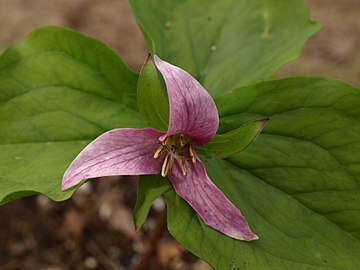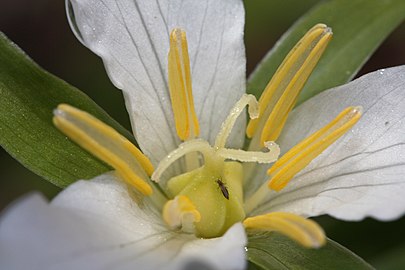Trillium ovatum
| Trillium ovatum | |
|---|---|

| |
| Pacific trillium blooming in Aldergrove Regional Park (British Columbia, Canada). | |
| Scientific classification | |
| Kingdom: | Plantae |
| Clade: | Tracheophytes |
| Clade: | Angiosperms |
| Clade: | Monocots |
| Order: | Liliales |
| Family: | Melanthiaceae |
| Genus: | Trillium |
| Species: | T. ovatum
|
| Binomial name | |
| Trillium ovatum Pursh, 1814
| |
| Synonyms[2] | |
|
show
Synonymy | |
Trillium ovatum, the Pacific trillium, also known as the western wakerobin, western white trillium, or western trillium, is a species of flowering plant in the family Melanthiaceae.[1][3][4][5] It is found in western North America, from southern British Columbia and the tip of southwestern Alberta to central California, east to Idaho and western Montana. There is an isolated population in northern Colorado and southern Wyoming.[6]
T. ovatum is the most widespread and abundant trillium in western North America.[7] It is the only pedicellate-flowered Trillium species found within its range.[8] The type specimen for this species was gathered by Meriwether Lewis in 1806 along the Columbia River during the return trip of the Lewis and Clark Expedition.[9]
Taxonomy[]
In addition to Trillium ovatum Pursh, the following infraspecific taxa are accepted:
- Trillium ovatum f. hibbersonii T.M.C.Taylor & Szczaw.[10]
- Trillium ovatum var. oettingeri (Munz & Thorne) Case[11]
- Trillium ovatum var. ovatum[12]
The form T. o. f. hibbersonii, sometimes called the dwarf trillium[13] (not to be confused with T. pusillum), is a mere 3 to 10 cm (1 to 4 in) tall. Unlike the nominate variety T. o. var. ovatum,[14] the flower petals open pink but fade to white as they age. The form hibbersonii is found primarily on Vancouver Island in British Columbia but occurs occasionally throughout the range of the species.[15][16]
The variety T. o. var. oettingeri is endemic to the Salmon Mountains of northwestern California and hence Oettinger's trillium is known as the Salmon Mountains wakerobin.[17] Unlike the nominate variety T. o. var. ovatum, the variety oettingeri has leaves with short petioles and linear flower petals.[18][19][20]
Numerous synonyms are in use. For instance, the synonym Trillium ovatum f. maculosum Case & R.B.Case refers to a form with mottled leaves that occurs in Mendocino County, California. This is the only reported instance of mottled leaves in a pedicellate Trillium.[15][19]
Description[]
The most widespread of the western North American trilliums, Trillium ovatum varies greatly within its range. Despite this, T. ovatum closely resembles the eastern T. grandiflorum. Apart from geographic location, the two species are not easily distinguished.[21]
T. ovatum is a perennial herbaceous plant that spreads by means of underground rhizomes. At maturity, each plant has one or two flowering scapes, each 20 to 50 cm (8 to 19.5 in) in length. The specific epithet ovatum means “egg-shaped,” which refers to the petals, not the leaves. The latter are generally ovate-rhombic, 7 to 12 cm (3 to 5 in) long by 5 to 20 cm (2 to 8 in) wide.[3]
The flower sits on a pedicel 2 to 6 cm (1 to 2.5 in) in length. The sepals are 15 to 50 mm (0.59 to 1.97 in) long and 6 to 20 mm (0.24 to 0.79 in) wide, while the petals are 15 to 70 mm (0.59 to 2.76 in) long and 10 to 40 mm (0.39 to 1.57 in) wide. Typically the flower opens white and becomes pink with age, but in the Smith River Canyon area of northern California and southern Oregon, the petals become almost barn-red.[22]
Supported by thin white filaments, the yellow anthers are 4–16 mm long

The flower starts white, but often becomes pink as it matures
Habitat and ecology[]
Trillium ovatum is often found growing in coniferous and mixed coniferous-deciduous forests, in and around alder thickets and shrubs.[15] Along the California coast, it is commonly found under coast redwood and mixed evergreen forest.[5] At Lolo Pass, Montana, it grows under spruce and Douglas fir in ravines along mountain streams.[23]
Flowers bloom late February in the southern part of its range, and in March or April elsewhere. Citizen science observations of flowering plants of this species peak during the first week of April.[24] For comparison, when Trillium grandiflorum is fully open in eastern North America, T. ovatum is already fading in western North America. Apparently T. ovatum lacks sufficient winter hardiness to flourish east of the continental divide.[7][25]
The life-cycle stages of T. ovatum include a cotyledon stage, a one-leaf vegetative stage, a three-leaf vegetative (juvenile) stage, a three-leaf reproductive (flowering) stage, and a three-leaf nonflowering regressive stage. An example of the latter involves a transition from the three-leaf flowering stage to a three-leaf nonflowering regressive stage. Approximately one of every four reproductive plants regresses to a nonflowering state in any given year.[26] Under the right conditions, individuals may undergo extended dormancy, that is, they may cease above-ground growth for one or more years. In western Montana, dormancy was observed in all adult stage classes, with most plants returning to above ground status in a year or two, although some plants exhibited dormancy for 3–5 years.[27]
Bibliography[]
- Case, Frederick W.; Case, Roberta B. (1997). Trilliums. Portland, Oregon: Timber Press. ISBN 978-0-88192-374-2.
- Pursh, Frederick (1814). Flora Americae Septentrionalis; or A systematic arrangement and description of the plants of North America. London. LCCN 05024608. Retrieved 8 September 2019.
- Ream, Tarn (2011). Life History and Demography of Trillium ovatum Pursh. (Liliaceae) in Western Montana (MIS). The University of Montana. Retrieved 2019-10-21.
References[]
- ^ Jump up to: a b "Trillium ovatum". NatureServe Explorer. NatureServe. Retrieved 2008-05-02.
- ^ "Trillium ovatum". World Checklist of Selected Plant Families (WCSP). Royal Botanic Gardens, Kew.
- ^ Jump up to: a b Case Jr., Frederick W. (2002). "Trillium ovatum". In Flora of North America Editorial Committee (ed.). Flora of North America North of Mexico (FNA). 26. New York and Oxford – via eFloras.org, Missouri Botanical Garden, St. Louis, MO & Harvard University Herbaria, Cambridge, MA.
- ^ "Trillium ovatum". Natural Resources Conservation Service PLANTS Database. USDA. Retrieved 15 December 2015.
- ^ Jump up to: a b "Trillium ovatum". Calflora: Information on California plants for education, research and conservation. Berkeley, California: The Calflora Database – via www.calflora.org.
- ^ "Trillium ovatum". County-level distribution map from the North American Plant Atlas (NAPA). Biota of North America Program (BONAP). 2014.
- ^ Jump up to: a b Case & Case (1997), p. 120.
- ^ Case Jr., Frederick W. (2002). "Trillium". In Flora of North America Editorial Committee (ed.). Flora of North America North of Mexico (FNA). 26. New York and Oxford – via eFloras.org, Missouri Botanical Garden, St. Louis, MO & Harvard University Herbaria, Cambridge, MA.
- ^ Pursh (1814), pp. x–xii, 245.
- ^ "Trillium ovatum f. hibbersonii". World Checklist of Selected Plant Families (WCSP). Royal Botanic Gardens, Kew.
- ^ "Trillium ovatum var. oettingeri". World Checklist of Selected Plant Families (WCSP). Royal Botanic Gardens, Kew.
- ^ "Trillium ovatum var. ovatum". World Checklist of Selected Plant Families (WCSP). Royal Botanic Gardens, Kew.
- ^ Douglas, George W.; Pojar, Jim (2001). "Dwarf Trillium". Canadian Field-Naturalist. 115 (2): 343. Retrieved 9 September 2019.
- ^ Pistrang, Mark. "Western White Trillium (Trillium ovatum var. ovatum)". United States Forest Service. Retrieved 7 October 2019.
- ^ Jump up to: a b c Case Jr., Frederick W. (2002). "Trillium ovatum var. ovatum". In Flora of North America Editorial Committee (ed.). Flora of North America North of Mexico (FNA). 26. New York and Oxford – via eFloras.org, Missouri Botanical Garden, St. Louis, MO & Harvard University Herbaria, Cambridge, MA.
- ^ Case & Case (1997), pp. 116–118.
- ^ "Trillium ovatum ssp. oettingeri". California Native Plant Society. Retrieved 2 August 2019.
- ^ Case Jr., Frederick W. (2002). "Trillium ovatum var. oettingeri". In Flora of North America Editorial Committee (ed.). Flora of North America North of Mexico (FNA). 26. New York and Oxford – via eFloras.org, Missouri Botanical Garden, St. Louis, MO & Harvard University Herbaria, Cambridge, MA.
- ^ Jump up to: a b Case & Case (1997), pp. 118–119.
- ^ Pistrang, Mark. "Salmon Mountain wake robin (Trillium ovatum var. oettingeri)". United States Forest Service. Retrieved 7 October 2019.
- ^ Case & Case (1997), pp. 114–115.
- ^ Case & Case (1997), p. 39.
- ^ Case & Case (1997), p. 116.
- ^ "Pacific Trillium (Trillium ovatum)". iNaturalist. Retrieved 10 September 2019.
- ^ Ream (2011), pp. 2–3.
- ^ Ream, Tarn (Summer 2011a). "Trillium ovatum in Western Montana: Implications for Conservation" (PDF). Kelseya, the Newsletter of the Montana Native Plant Society. 24 (4): 1. Retrieved 22 October 2019.
- ^ Ream (2011), p. 57.
External links[]
- NatureServe secure species
- Trillium
- Ephemeral plants
- Flora of the Western United States
- Plants described in 1813
- Taxa named by Frederick Traugott Pursh
- Garden plants of North America


